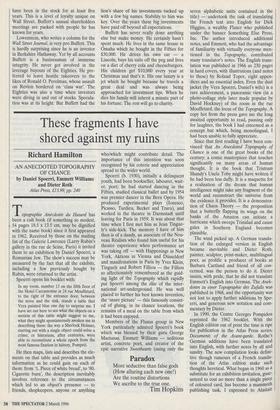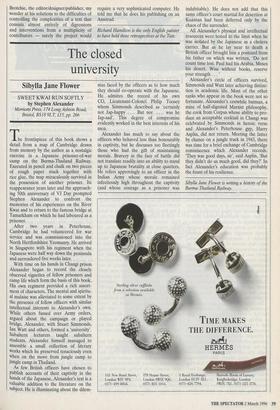These fragments I have shored against my ruins
Richard Hamilton
AN ANECDOTED TOPOGRAPHY OF CHANCE by Daniel Spoerri, Emmett Williams and Dieter Roth Atlas Press, £13.99, pp. 240 Topographie Anecdotee du Hasard has been a cult book (if something so modest, 54 pages 18.5 x 13.5 cm, may be dignified with the name book) since it first appeared in 1962. Received by those on the mailing list of the Galerie Lawrence (Larry Rubin's gallery in the rue de Seine, Paris) it invited them to an exhibition by Daniel Spoerri, a Romanian Jew. The show's success may be measured by the fact that all the exhibits, including a few previously bought by Rubin, were returned to the artist.
Spoerri opens his booklet with: In my room, number 13 on the fifth floor of the Hotel Carcassonne at 24 rue Mouffetard, to the right of the entrance door, between the stove and the sink, stands a table that Vera painted blue one day to surprise me. I have set out here to see what the objects on a section of this table might suggest to me, what they might spontaneously awaken me in describing them: the way a Sherlock Holmes, starting out with a single object could solve a crime; or historians, after centuries, were able to reconstitute a whole epoch from the most famous fixation in history, Pompeii.
He then maps, lists and describes the ele- ments on that table and provides as much information as he could gain on each of them: from '1. Piece of white bread', to '80. Cigarette burn', the description inevitably involves reference to the circumstances which led to an object's presence — to friends, shopkeepers, anyone or anything who/which might contribute detail. The importance of this intention was soon recognised by his coterie and appreciation spread to the wider world.
Spoerri (b. 1930), initially a delinquent youth, had been bookseller, labourer, wait- er, poet; he had started dancing in the Fifties, studied classical ballet and by 1954 was premier dancer in the Bern Opera. He produced experimental plays (Ionesco, Picasso, Tardieu, Becket and Tzara), and worked in the theatre in Darmstadt until leaving for Paris in 1959. It was about that time when I first met him as Jean Tingue- ly's side-kick. The memory I have of him then is of a dandy, an associate of the Nou- veau Realists who found him useful for his theatre experience when performance art was taking off — with Happenings in New York, Aktions in Vienna and Dusseldorf and manifestations in Paris by Yves Klein, Tinguely and Robert Filliou — the Filliou so affectionately remembered as the guid- ing light of the Topography which rapidly put Spoerri among the elite of the inter- national art-underground. He was well placed to further his best known invention, the 'snare picture' — this famously consist- ed of gluing, in its chance locations, the remains of a meal on the table from which it had been enjoyed.
Members of the Fluxus group in New York particularly admired Spoerri's book which was blessed by their guru George Maciunas. Emmett Williams — seditious artist, concrete poet, and creator of the epic narrative Sweethearts (using only the seven alphabetic units contained in the title) -- undertook the task of translating the French text into English for Dick Higgins, a wealthy Fluxer who published under the banner Something Else Press, Inc. The author introduced additional notes, and Emmett, who had the advantage of familiarity with virtually everyone men- tioned in the Topography, contributed many translator's notes. The English trans- lation was published in 1966 as 230 pages in hard covers, with illustrations (and notes to these) by Roland Topor, eight appen- dices and an essential index. Even the dust jacket (by Vera Spoerri, Daniel's wife) is a rare achievement, a panoramic view (in a photo-collage style later made popular by David Hockney) of the room in the rue Mouffetard, the locus of the Topography. A copy hot from the press gave me the long awaited opportunity to read, pausing only for laughter, the book I had esteemed as a concept but which, being monolingual, I had been unable to fully appreciate.
Since that first reading I have been con- vinced that An Anecdoted Topography of Chance is one of the great books of the century; a comic masterpiece that touches significantly on many areas of human thought. It is the book that Tristram Shandy's Uncle Toby might have written if he had been less daffy. It is a maquette for a realisation of the dream that human intelligence might take any fragment of the world and reconstruct the universe from the evidence it provides. It is a demonstra- tion of Chaos Theory — the proposition that a butterfly flapping its wings on the banks of the Amazon can initiate a hurricane which sweeps Trinidad and cause gales in Southern England becomes plausible.
The wind picked up. A German transla- tion of the enlarged version in English became inevitable and Dieter Roth, painter, sculptor, print-maker, multilingual poet, as prolific a producer of books as Barbara Cartland and friend of all con- cerned, was the person to do it. Dieter insists, with pride, that he did not translate Emmett's English into German. The Anek- doten zu einer Topographie des Zufalls was published in 1968, and the opportunity was not lost to apply further additions by Spo- erri, and generous new notation and com- mentary by Dieter.
In 1990, the Centre Georges Pompidou reprinted the 1962 booklet. With the English edition out of print the time is ripe for publication in the Atlas Press series, Documents of the Avant-garde. Rothe's German additions have been translated into English, with further notes by all and sundry. The new compilation looks defini- tive though rumours of a French transla- tion of the Atlas edition make such thoughts heretical. What began in 1960 as a substitute for an exhibition invitation, guar- anteed to cost no more than a single piece of coloured card, has become a mammoth publishing task, I expressed to Alastair Brotchie, the editor/designer/publisher, my wonder at his solutions to the difficulties of controlling the complexities of a text that consists almost entirely of digressions and interventions from a multiplicity of contributors — surely the project would require a very sophisticated computer. He told me that he does his publishing on an Amstrad.
Richard Hamilton is the only English painter to have held three retrospectives at the Tate.



































































 Previous page
Previous page